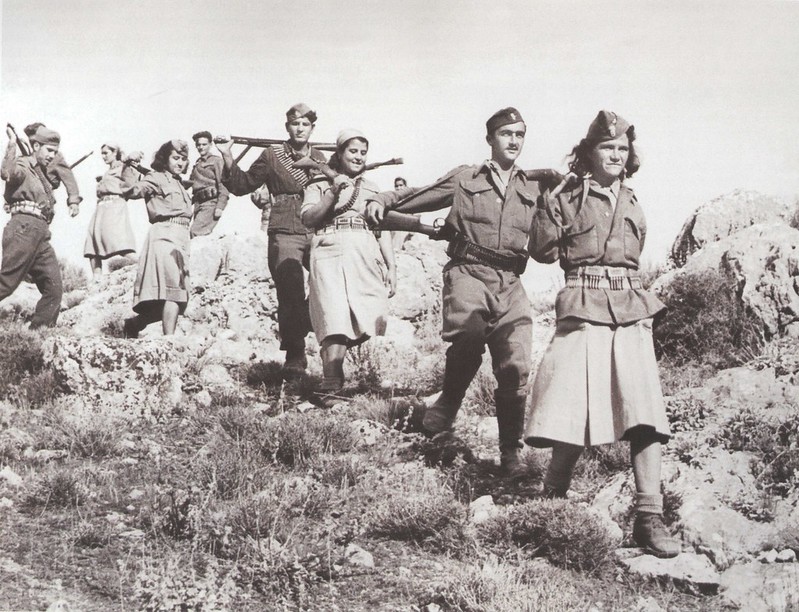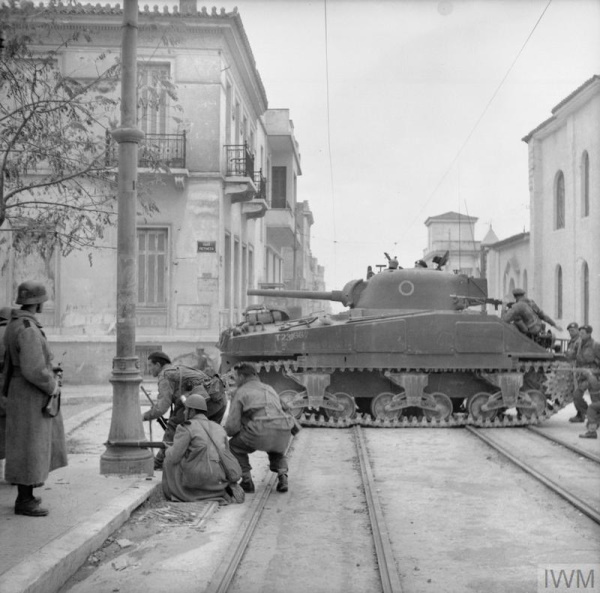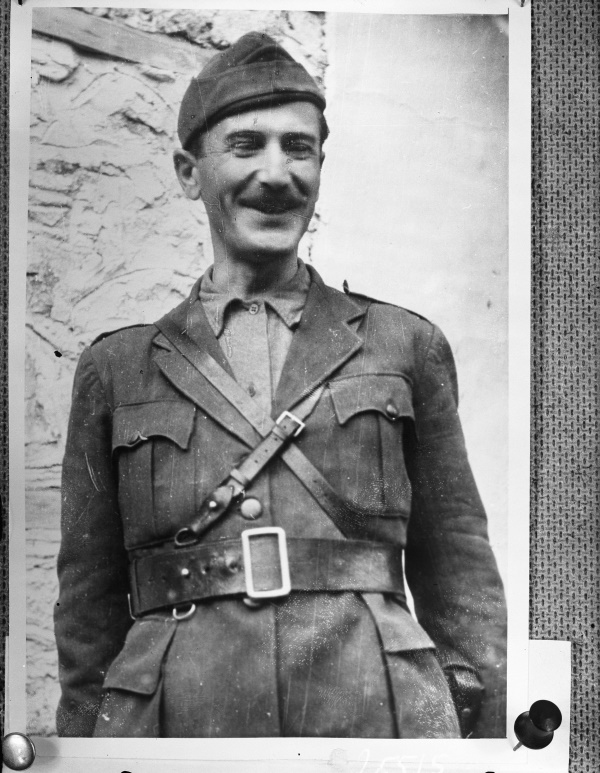

Table of Contents
In May 1945 the war ended in Europe. The moment was welcomed with relief by millions on the old continent as years of death and despair came to an end. Still, the shadow of war still hung over Europe. Without Nazis on the scene, new hostilities were born. On the ruins of the European pre-war political system, Communism began to rise. Following the footsteps of the Red Army, communists seized the rule in the entire Eastern Europe. Only in Greece did the communists meet resistance. It was a prelude to the Greek Civil War - the first armed conflict in Europe after World War Two.
On Three Different Paths
The roots of the Greek Civil War date back to the pre-war period when Greece was a country deeply divided along political lines. From 1936, the country was led by the military junta of General Ioannis Metaxas. The Greek Communist Party (KKE), openly opposing the ruling system, was already banned at the time. Still, they were very active in their agenda and supported by the broader population.
In April 1941 the country was invaded by Germans and Italians forcing King George II and the government into exile. With three other leftist parties, the communist party started organizing a resistance group, the National Liberation Front (EAM). In February 1942 the EAM formed its military wing, the Greek People’s Liberation Army (ELAS). ELAS was the most dominant resistance force in Greece, but not the only one. Nationalists, as well, organized themselves for resistance. Their group, the National Republican Greek League - EDES was smaller by strength than ELAS and operated mainly in the region of Epirus. Their advantage, however, was the support of the government in exile backed up by substantial military aid from the British.
The third, and the last formed, movement was EKKA - National and Social Liberation. Their region of operation was in eastern central Greece.

Rebels of EAM/ELAS by Υπουργείο Εξωτερικών licensed by CC BY-SA 2.0
The First Round
In a situation where Germans and Italians were engaged in protecting only vital communications and large settlements, Greek resistance relatively easily took control of the inland. The uprising against occupiers soon took a whole different course. Already in 1942, resistance movements started attacking each other. EAM leaders were determined to monopol the resistance in order to gain advantage in the post-war political arrangements. EDES disputed the leadership of the EAM for the same reason. The way they saw it, Communism was an equal threat to Greece as Nazis were.
By the end of 1942, ELAS, EDES and EKKA were spending more time fighting each other than against Germans and Italians. For the British, it was of greatest importance for these quarrels to stop. In March 1943 they initiated the signing of the National Bands Agreement to stop all hostilities.
In September 1943, the conflict renewed. The surrender of Italy was a sign for ELAS that the war was near and that the time was right to eliminate their rivals. In a rush to capture Italian weapons and equipment, ELAS attacked both EDES and EKKA. It was a point of no return, despite the signing of the Plaka Agreement to once again cease all hostilities. By the end of the war, ELAS anihilated EKKA and pushed EDES to a restricted region in Epirus. They became the most dominant resistance force in the country.
Many historians believe this period to be the first round of the Civil War in Greece.
“National Unity”

Geórgios Papandreou and others on the Acropolis of Athens, after the liberation from the Axis powers by Υπουργείο Εξωτερικών - licensed by CC BY-SA 2.0
In autumn 1944 the war was coming to an end. Red Army troops entered Romania and Bulgaria and were preparing to storm Yugoslavia. The Germans had no choice but to retreat. On October 12, 1944 they withdrew from Athens. Six days later British troops entered the capital of Greece along with the Greek government that returned from exile. To make a fresh start, a new prime minister was appointed - Georgios Papandreu.
Before the government returned to Athens, an agreement was signed in Caserta, Italy between the Supreme Allied Command Mediterranean Theater, the Greek Government, EAM and EDES. The Caserta Agreement put all forces in Greece under the control of the new government. In return, the EAM was promised to enter the government of “National Unity” under “supervision” of Lieutenant-General Ronald Scobie, commander of the British 3rd Corps in Greece.
EAM gave up on the advantage they gained during the war by signing the agreement. They did it because they were instructed so from Moscow. Stalin believed that any clash with the Allies might have jeopardized further operations against the Germans. There was also a secret agreement between him and Churchill on the division of influences in Eastern Europe. By that agreement, Greece fell into the British sphere of influence. Even though communists agreed to put ELAS under the control of the government, the British still feared they posed a threat. To deal with it, they persuaded the government in Athens to demand a disarmament of all armed forces in Greece. Only two units would remain: the 3rd Mountain Brigade and the Sacred Band, both loyal to the government. Communists saw through the government’s intentions and strongly opposed the disarmament.. Unsatisfied with the prime ministers’ demand, six KKE members of the government resigned from their positions. On december 3, 1944, KKE organized a massive demonstration in Athens.
Dekemvriana

5th Scottish Parachute Battalion Athens 1944 - by Powell-Davies (Lt). Public domain
The events that started on December 3rd pushed the country into a true Civil War. Around 200,000 people gathered on the streets of Athens marching toward the Tomb of the Unknown Soldier at Syntagma Square. As protesters approached the Tomb, the police opened fire on them. At least 28 protesters were killed that day, with hundreds more wounded. Two days later, during the funeral procession, another incident happened, which ended with more than 100 dead.
Athens exploded. Protests turned into true street fights. On one side, there were members of KKE, their security militia OPLA as well as ELAS soldiers. Against them were the British, soldiers of the 3rd Mountain Brigade, Sacred Band, Athens police and members of the notorious far-right Organization X. Needless to say, ELAS was still a force to be reckoned with. In a matter of a week, they put the entire city of Athens under control. The situation was dramatic and forced the British to call in reinforcements from Italy. By the end of December 1944, British and Government troops regained control over the city.
Conflict between British troops and resistance formations, while the war was still going on, was pretty embarrassing. That was why British prime minister Winston Churchill came to Athens to solve the dispute. On January 15, 1945, Communists and General Scobie signed a ceasefire agreement. ELAS ceded their positions in Thessaloniki and Patras and demobilized its forces in Peloponnesus.
On February 12, KKE and a number of other parties signed the Varkiza Treaty, putting an end to Dekemvriana (December Events). All paramilitary groups, including ELAS, were demobilized. Amnesty was proclaimed for political offenses and general elections and a referendum on the monarchy was arranged. Once again, KKE gave way to the government. Their leader Nikolaos Zachariadis travelled to Germany earlier that year and probably received instructions from Soviets to give up on a violent agenda.
The Second Round
There was a strong, uncompromising faction inside KKE that opposed demobilization. Once ELAS ceded weapons, they were exposed to massive oppression in the entire country. Tens of thousands of communists and their sympathizers were arrested, with many being executed. Proclaimed amnesty was put aside as the majority of communists arrested were accused of criminal, not political activities during the war and Dekemvriana. In late 1945 the state of international affairs was, however, much different than a few months earlier. A dispute between the Soviets and western Allies was opening the era of new conflict. Encouraged by the Soviets, the KKE took a more serious stand. The breakup with the political establishment KKE was announced with a decision to boycott the 1946 elections and referendum. The elections were later won by Nationalists and the monarchy was restored. On the night before the election, a small band of ex-ELAS fighters attacked the police station in Litochoro and killed the policemen. The second round of the Greek Civil War was about to begin. KKE made a new start. The Democratic Army of Greece (DSE) was formed, consisting of ELAS veterans who were hiding from persecutions in Yugoslavia and Albania. The leader of the DSE was Markos Vafiadis, a.k.a. General Markos. Greek communists were denied public backing from the Soviets but they received support, however. Yugoslavia, a country bordering Greece in the north, was run by communist leader Josip Broz Tito. Unlike his Greek comrades, during the war Tito disobeyed orders from Moscow and pushed his fight to the end and won. Tito was the only leader who all the time pushed Greek communists to follow his path. In 1946, he was there to help them once again.
Not only were DSE fighters trained in camps in Yugoslavia, but DSE also received substantial amounts of weaponry, including artillery and AA guns.
What in early stages of the Greek Civil War was a group of ragged bandits, under the command of General Marcos became a thorn in the eye of the government. Practicing hit-and-run tactics, small DSE units frequently attacked police stations and gendarmerie posts. With each day, DSE’s power was rising. By mid-1947 they had 23,000 men under arms.
All the time the Government showed absolutely no capability to deal with insurgents. Gendarmerie troops deployed to fight the DSE were undertrained and above everything low in morale. In 1947, more than two thirds of the country was beyond their reach.
Carried by military success, the KKE decided in late 1947 to form a parallel government and switch to full-scale military operations. The town of Konitsa was designated as the seat of the government. In December 1946, DSE attacked the garrison in Konitsa, but suffered a major defeat. DSE fighters were well trained for guerilla operations, but were lacking both organization and discipline for conventional warfare.
For the government, victory at Konitsa was a relief and a sign of hope that they could win the war. In an effort to win a decisive victory against communists, more important was the American engagement in Greek affairs. In 1947, Britain definitively withdrew from Greece. The new, labourist, government had no sources nor will to continue their engagement in Greece. Instead, the US Government through the program of Truman Doctrine provided the Greeks with a huge financial and military aid in order to crush the communist rebellion. Small arms, artillery, tanks and planes were coming in huge amounts. With the increased number of soldiers, the Greek Army finally had everything they needed to defeat the communists.

Markos Vafeiadis, a.k.a. General Markos 1948 by unknown author - licensed by BY-SA 3.0 NL
The Dawn of The End
On April 15, 1948 government’s forces launched Operation DAWN. Groups of mountain commandos were sent to hunt down insurgents in remote mountain regions. Commandos located DSE groups by night and attacked them by surprise at dawn. At the same time, the Army launched a massive offensive against DSE troops in Peloponnese, crushing their 3rd Division. MIlitary operations were followed by severe prosecutions of communists and their sympathizers in urban areas. During that time, KKE and DSE were losing ground as well as public support. Between 1946 and 1947 KKE commissars forcefully displaced around 30,000 children from the regions they controlled. Children were sent to Eastern European countries to be brought up in communist fashion. Such actions have largely affected the local population and caused insurgents to lose their sympathies. The crucial event that led to the collapse of the KKE’s insurgence was the breakup between the Soviet Union and Yugoslavia. Yugoslav communists were declared as outcasts by Soviets and expelled from the Cominform. Greek communists took Soviets’ side and thus automatically lost the support of Yugoslavs. Military aid stopped arriving, training camps in Yugoslavia were shut down and the border closed for insurgents to hide in case of an enemy offensive. DSE was on their own. After dealing with DSE insurgents in the south and the rest of the country, the Greek Army turned toward insurgent strongholds in the North. On August 2, 1949, Operation Torch was launched. Around 150,000 soldiers of the Greek army, supported by artillery, tanks and air force, attacked DSE’s positions on the Grammos and Vitsi Mountains. After four weeks of intense combat, DSE fighters were brought on the verge of annihilation. The KKE had no other choice but to order its combatants to leave their positions and flee to Albania. After the Operation Torch was finished, it became evident to the KKE, but to Soviets as well, that the fight for the communist republic was over. Led by instructions from Moscow in October 1949 KKE declared a temporary cessation of all hostilities. Out of the mighty force ELAS once was, only 1,000 fighters remained. More than 100,000 soldiers and communist sympathizers were arrested. The core of the DSE left Greece even before the cessation was declared. They went to Tashkent, Soviet Union where they spent the next three years in military camps. Their families and older soldiers were exiled to countries of the Eastern Bloc.

Government army unit during the Greek Civil War. The State Archives of the Republic of Macedonia. Public Domain
Conclusion
After 158,000 lives were lost and many more left without homes, the Greek Civil War was over. What was left was a devastated country and polarized society that had to go through a long and stressful period of reconciliation.
Further reading
-
Close, David. The Origins of the Greek Civil War. Longman, 2001
-
Athens - Britains Dirty Secret from theguardian.com
-
Greek Civil War from historynet.com
